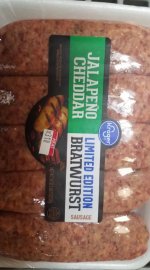So I've got a question about the cast iron griddle...about the stainless steel grates....about seasoning in general actually.
Last summer we bought a Blackstone griddle, and I bet I watched 200 hours of videos on "how to season a griddle". Cuz I watched most of them multiple times.
I came to the conclusion that seasoning is not rocket science. My mom was good at it. She would burn off the crud on a cast iron skillet by putting it in the coals of a hot fire and leaving it overnight, as I previously described. Then when she got it out and pronounced it a decent skillet, she cleaned it with an SOS pad, washed it with dish soap, wiped it dry, wiped it with a light coating of whatever oil she had (often it was probably lard) and stuck it in her oven, on very low heat, overnight. In the morning, you had the slickest, blackest skillet you ever did see.
At this point, the skillet took its place in her kitchen, OR she gave it to one of her two daughters. (My mom yard sale shopped for us until she no longer could, looking for good cast iron.)
So the Blackstone. ALL the cool people said to clean it with water (while on low heat) after cooking, then seal it with a light coating of oil (no shocker there) and cook that ON HIGH HEAT for ten minutes.
Now then, according to my mom, high heat was NOT THE WAY NOT THE WAY, TURN THAT HEAT DOWN, PRIVATE, AND GIVE ME TWENTY!
So here I am, with this NEW LODGE griddle. The only wrench in the works, is that it's sitting on a GRILL. A GAS grill where low heat can be had, I think, with one burner, and the lid propped open.
So I'm about to plop some skinless salmon on this grill, and my instincts say, "don't put it on the stainless grates. I think I'll lose half of it.
SO...I can always sear it on the griddle.
But that griddle is still kinda rough, so Ima lose some seared fish on that rough surface.
I would like to have a discussion about sophisticated seasoning techniques for use in this instance. My GOOD cast iron skillets (via mom) are as smooth as glass. Cuz...they're seasoned the way a skillet should be. The Lodge griddle...it ain't that smooth.
SO.... (once my oven is installed in my kitchen--God knows when I'll get THAT done) I can bring this griddle in and season it to my mom's standards.
But in the meantime, I've got the Weber. (no indoor range. Just a toaster oven, and that won't take the griddle)
I would like to know if there is a way to season this new griddle the way it should be, to a smooth surface (that takes several coats I think, cuz it is not a smooth surface--hmmm...maybe I need to grind it down a little)
I have observed that discussions about seasoning cast iron are as divisive as discussions about beans in chili or 9mm vs .45.
So even though it's a risk to ask this question....
Tell me how y'all, who love grills and grilling, season stuff that you use on the grill?

